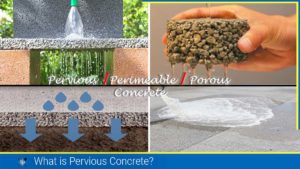Introduction
The workability of concrete refers to its ability to be easily mixed, placed, compacted and finished without segregation or bleeding. It is a critical property of concrete as it affects the ease and efficiency of the construction process, and ultimately the strength and durability of the finished structure.
Factor Affecting Workability of Concrete
The factor affecting workability of concrete refers to its ability to be easily mixed, placed, and compacted without excessive segregation or bleeding. Several factors can affect the workability of concrete, including:
The workability of concrete depends on several factors, including the water-cement ratio, the amount and type of cementitious materials, the size and shape of aggregates, the presence of admixtures, and the ambient temperature and humidity.
Water Content:
The amount of water used in the mix can significantly affect the workability of concrete. Too much water can cause segregation, while too little water can make the mix too stiff and difficult to work with.
Water content is one of the most important factors affecting the workability of concrete. The amount of water used for mixing can greatly affect the consistency and ease of handling of concrete during mixing, placement, and finishing. This is how water content affects the workability of concrete.
- Too much water: Adding excess water to the mix can result in segregation, bleeding, and reduced strength. The concrete will be more fluid, which may make it easier to mix, place and finish, but it will also lead to excessive bleeding, where the water accumulates on the surface, leaving behind voids. This may cause weaker, more porous concrete that is more prone to cracking and shrinkage.
- Too little water: If you don’t add enough water to the mix, the concrete can become stiff and difficult to mix and place. This can make concrete difficult to handle, lead to poor compaction, reduce strength, and develop honeycombs and voids.
- Optimum water content: Finding the optimum amount of water is crucial for achieving the desired workability, strength, and durability of the concrete. The ideal amount of water in the mix will provide enough workability to allow easy handling and placing, while still maintaining the desired strength and durability characteristics.
Aggregate Size and Shape:
The size and shape of the aggregate used in the mix can significantly affect the workability of concrete. The size and shape of the aggregates in the mix can impact the amount of water needed to achieve the desired consistency, the ease of mixing and placing, and the uniformity of the concrete. Here’s how the aggregate size and shape can affect the workability of concrete:
- Aggregate size: Larger aggregates require more water to achieve the desired workability and may also increase the risk of segregation during mixing and placing. Smaller aggregates may require less water but can also lead to a more cohesive mix that is more difficult to handle and place. Ideally, the aggregates should be well-graded to ensure a dense and workable mix.
- Aggregate shape: The shape of the aggregates can also affect the workability of the concrete. Angular and rough-textured aggregates may require more water to achieve the desired workability and may increase the friction between the aggregates during mixing and placing. This can result in a less workable mix that is more difficult to handle and place. In contrast, smooth and rounded aggregates may require less water to achieve the desired workability, resulting in a more workable mix that is easier to handle and place.
Therefore, it is important to carefully select and proportion the aggregates in the mix to achieve the desired workability, while ensuring that the concrete mix is well-proportioned, properly mixed, and correctly placed to achieve the desired strength and durability. A well-graded mix with a balanced proportion of different sizes and shapes of aggregates can help achieve the desired workability and other properties of concrete.
Cement Content:
The amount of Cement content in the mix can significantly affect the workability of concrete. The amount of cement in the mix can significantly affect the consistency and ease of handling of the concrete during mixing, placing, and finishing. Here’s how the cement content can affect the workability of concrete:
- Higher cement content: Increasing the cement content can increase the stiffness of the mix and decrease its workability. A mix with a higher cement content requires more water to achieve the desired consistency, but the increased water content can lead to segregation, bleeding, and reduced strength. Increasing the cement content can also increase the heat of hydration, which can lead to thermal cracking and other problems.
- Lower cement content: Decreasing the cement content can increase the workability of the mix, but it can also result in lower strength and durability of the resulting concrete. A mix with a lower cement content may also be more prone to cracking and shrinkage, especially if the water-cement ratio is not adjusted accordingly.
- Optimum cement content: Finding the optimum amount of cement is crucial for achieving the desired workability, strength, and durability of the concrete. The ideal amount of cement in the mix will provide the desired strength and durability characteristics while still maintaining a workable consistency.
Therefore, it is important to maintain the correct cement-water ratio while ensuring that the concrete mix is well-proportioned, properly mixed, and correctly placed to achieve the desired workability and strength. A well-graded mix with a balanced proportion of cement and aggregates can help achieve the desired workability and other properties of concrete.
Type of Cement:
The characteristics of cement can also have an effect on its workability of concrete. For instance, cement with a higher degree of fineness may require more water to achieve the same workability as cement with a lower degree of fineness. Additionally, cement with a higher percentage of Al2O3 or C2S content may have a higher water demand, which can make it more difficult to achieve the desired workability. Therefore, it is important to consider the characteristics of the cement being used when designing a concrete mix to ensure that the desired workability can be achieved with the appropriate water-cement ratio.
Admixtures:
The use of admixtures, such as water reducers, plasticizers, or superplasticizers, can improve the workability of concrete. These admixtures can reduce the amount of water needed in the mix while maintaining its workability, here are some ways that admixtures can affect workability:
- Water-reducing admixtures: These admixtures reduce the amount of water needed to achieve the desired workability, resulting in a more fluid mix that is easier to place and finish. Water-reducing admixtures can also improve the strength and durability of concrete by reducing the water-cement ratio.
- Superplasticizers: These admixtures are similar to water-reducing admixtures but have a more significant effect on workability. Superplasticizers can greatly increase the fluidity of the mix while maintaining the same water-cement ratio, making it easier to place and finish.
- Retarding admixtures: These admixtures slow down the rate of setting and hardening of concrete, which can improve workability by giving more time for placing and finishing. Retarding admixtures is especially useful in hot weather conditions or when using a mix that requires a longer working time.
- Accelerating admixtures: These admixtures speed up the rate of setting and hardening of concrete, which can improve workability by allowing for earlier removal of forms and faster finishing.
- Air-entraining admixtures: These admixtures create small air bubbles in the mix, which can improve workability by increasing the plasticity of the mix and reducing bleeding and segregation.
Temperature:
Temperature can have a significant effect on the workability of concrete. Here are some ways that temperature can affect workability:
- High temperature: In hot weather conditions, the water in the mix can evaporate quickly, which can lead to a reduction in workability. Additionally, higher temperatures can cause the concrete to set more quickly, which can make it more difficult to place and finish.
- Low temperature: In cold weather conditions, the water in the mix can freeze, which can lead to a reduction in workability. Additionally, lower temperatures can cause the concrete to set more slowly, which can increase the amount of time needed for placing and finishing.
- Optimal temperature: To achieve optimal workability, the concrete mix should be mixed and placed at a temperature that is appropriate for the specific materials and equipment being used. The ideal temperature range for concrete placement is typically between 50-77°F (10-25°C).
- Water temperature: Water temperature can also affect the workability of concrete. If the mixing water is too hot or too cold, it can cause variations in the setting time and workability of the concrete. The ideal temperature for mixing water is typically between 50-77°F (10-25°C).
In summary, temperature can have a significant impact on the workability of concrete. It is important to ensure that the mix is placed at the appropriate temperature for the specific materials and equipment being used to achieve the desired workability, strength, and durability characteristics of the final product.
Mixing Time:
The length of time mixing concrete has affect in workability of concrete. The duration of mixing has a direct impact on the distribution of cement, water, and other components in the mix, which can ultimately affect its workability. Here are some ways that mixing time can affect the workability of concrete:
- Insufficient mixing time: If the concrete mix is not mixed thoroughly for a sufficient amount of time, it may result in a non-uniform distribution of components in the mix. This can cause variations in the workability, strength, and durability of the concrete, and may also result in air pockets or voids in the mix.
- Excessive mixing time: If the concrete mix is mixed for too long, it can lead to an increase in temperature and a reduction in workability. Over-mixing can cause the concrete to stiffen and become more difficult to place and finish, which can affect its final appearance and strength.
- Optimal mixing time: To achieve optimal workability, the concrete mix should be mixed for the appropriate amount of time to ensure that all components are uniformly distributed throughout the mix. The appropriate mixing time can vary depending on the specific materials and equipment being used but typically ranges from 2-5 minutes.
FAQs
1. What factor affects the workability of the concrete?
A. Several factors affect the workability of concrete, including the water-cement ratio, the size and shape of aggregates, the amount and type of cementitious materials, the presence of admixtures, and the ambient temperature and humidity.
2. What is the effect of aggregate size and shape on workability?
A. The size and shape of aggregates can affect the workability of concrete. If the aggregates are too large, they can make the mixture stiff and difficult to work with. If they are too small, they can increase the water demand and cause excessive bleeding. The shape of the aggregates can also affect workability, as angular or rough-surfaced aggregates may require more water and result in a stiffer mixture compared to smooth-surfaced aggregates.
3. What are the effects of admixtures on workability?
A. Admixtures can be used to improve the workability of concrete by reducing the water-cement ratio or by modifying the properties of the cement paste. For example, superplasticizers can increase the fluidity of the concrete, while air-entraining agents can improve workability by increasing the air content. The use of admixtures can help achieve the desired workability while maintaining the strength and durability of the finished concrete.
4. What is the effect of workability on finishing?
A. The workability of concrete can affect the ease and efficiency of finishing operations such as troweling, floating, and texturing. A concrete mix with a low workability may be difficult to finish, resulting in a surface that is uneven or does not have the desired texture. On the other hand, a mix with excessive workability may be prone to excessive bleeding, which can lead to surface defects.
![]()







